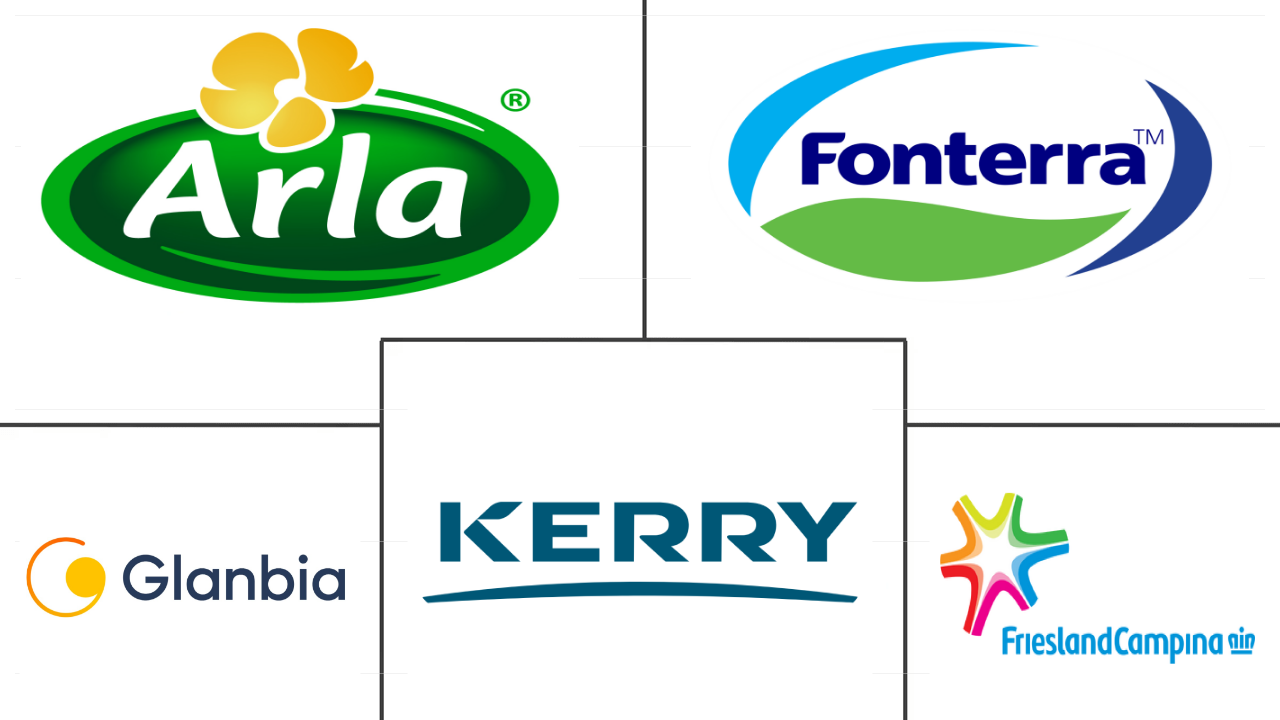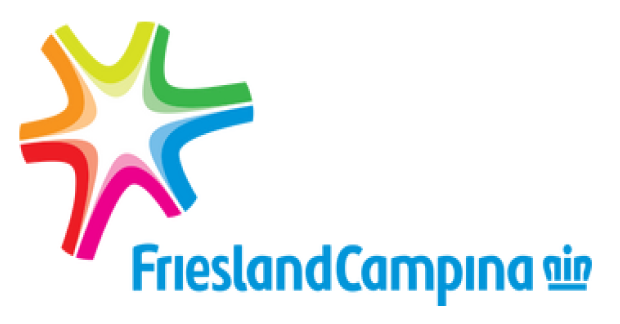Market Size of whey protein Industry
| Icons | Lable | Value |
|---|---|---|
|
|
Study Period | 2017 - 2029 |
|
|
Market Size (2024) | USD 2.32 Billion |
|
|
Market Size (2029) | USD 2.91 Billion |
|
|
Largest Share by End User | Food and Beverages |
|
|
CAGR (2024 - 2029) | 4.67 % |
|
|
Largest Share by Region | North America |
|
|
Market Concentration | Medium |
Major Players |
||

|
||
|
*Disclaimer: Major Players sorted in no particular order |
Whey Protein Market Analysis
The Whey Protein Market size is estimated at 2.32 billion USD in 2024, and is expected to reach 2.91 billion USD by 2029, growing at a CAGR of 4.67% during the forecast period (2024-2029).
2.32 Billion
Market Size in 2024 (USD)
2.91 Billion
Market Size in 2029 (USD)
4.78 %
CAGR (2017-2023)
4.67 %
CAGR (2024-2029)
Largest Market by Form
47.85 %
value share, Concentrates, 2023
WPCs are less expensive and offer a wider range of benefits, such as high bioavailability, BCAA, and high glutamine content, thus boosting its demand in the F&B and supplements segments.
Largest Market by End User
63.53 %
value share, Food and Beverages, 2023
Whey protein's high protein content, calorie-free nature, and ease of digestion are just a few of the benefits boosting the demand. Snacks dominate the application of whey protein in the F&B segment.
Fastest Growing Market by Form
6.27 %
Projected CAGR, Hydrolyzed, 2024-2029
As hydrolyzed whey protein is less expensive, it is gaining popularity among global manufacturers looking to make a low-cost product that appeals to a wider audience.
Fastest Growing Market by End User
5.95 %
Projected CAGR, Supplements, 2024-2029
It is becoming the fastest-growing segment due to the rising awareness of its benefits in aiding athletes to build a lean body and reduce the risk of gastrointestinal diseases in infants.
Leading Market Player
18.75 %
market share, Royal FrieslandCampina NV, 2021

To maintain its leadership position, the company focuses on performance nutrition. It introduced a new Native quality protein called 'Nutri Whey Native' which is a rapid digestion protein.
High-protein drinks with increasing number of fitness clubs drove the segmental demand
- The food and beverage segment held the biggest share of 67.20% by volume in 2022, owing to shifting preferences toward smaller meals, the substitution of conventional diets with more effective and accessible choices, such as protein-based snack bars, and increased demand for healthy drinks. Another factor driving the demand for healthy beverages is the global application of sugary food taxation.
- Asia-Pacific accounted for the largest market share, which is further projected to register a CAGR of 4.59% by value during the forecast period. Owing to the properties of whey, such as good water solubility and protein enrichment, its demand in the beverages segment increased. It is a good option for beverage manufacturers looking to develop high-protein drinks with good dispersibility. The number of fitness and health centers is also increasing in developing countries such as South Korea, China, and India. Whey protein intake is expected to increase among consumers in the region as many people choose a healthy lifestyle and better dietary options.
- The sport/performance nutrition sub-segment is projected to register the fastest CAGR of 5.9% by value during the forecast period. Whey protein supplementation helps athletes build lean body mass and boost muscle recovery. It is often used in conjunction with physiotherapy and psychotherapy to regain better vital signs and physical performances among athletes. These are the primary factors attributed to the rising number of muscle and fitness enthusiasts promoting WPS-based sports nutrition. For instance, in 2021, the US market had the largest number of health clubs, i.e., 38,477, followed by Brazil, with 34,509, and more than 7,000 gyms in the United Kingdom.
Demand is largely driven by North America followed by Asia-Pacific regions in the market
- North America dominates the worldwide whey protein market. Sports nutrition has always focused on protein content, which has probably grown even stronger in recent years, with over 40% of US launches between 2017 and 2022. Whey protein is absorbed much faster and is also a rich source of cysteine, an amino acid thought to prevent post-exercise muscle fatigue. Whey protein also has a much higher content of branched-chain amino acids that help reduce protein degradation during heavy exercise and boost muscle synthesis.
- Asia-Pacific was the second-largest market in 2022, and it is projected to grow with the fastest CAGR of 4.59%, by value, during the forecast period. China accounted for 37.58% of the market share, by value, in 2022, as high-protein goods have gained significant public attention in China in recent years, identifying protein as one of the most sought-after elements prior to food purchase. Consumers try and opt for healthier alternatives, such as whey proteins while snacking. Increasing health awareness and rising demand for snacking products with functional benefits are considered the major driving factors for the growth of the whey protein market.
- Other market segments continue to have enormous development potential, which is tempting multinational businesses to spend heavily in the whey market in Africa, South America, and the Middle East. People adopting an active lifestyle is helping to increase gym memberships and the consumption of sports nutrition products. Whey protein supplementation reduces muscle damage and facilitates muscle recovery from strenuous training, thereby assisting sports performance. For example, 2.78 million people in South Africa had fitness and health club memberships in 2021.
Whey Protein Industry Segmentation
Concentrates, Hydrolyzed, Isolates are covered as segments by Form. Animal Feed, Food and Beverages, Personal Care and Cosmetics, Supplements are covered as segments by End User. Africa, Asia-Pacific, Europe, Middle East, North America, South America are covered as segments by Region.
- The food and beverage segment held the biggest share of 67.20% by volume in 2022, owing to shifting preferences toward smaller meals, the substitution of conventional diets with more effective and accessible choices, such as protein-based snack bars, and increased demand for healthy drinks. Another factor driving the demand for healthy beverages is the global application of sugary food taxation.
- Asia-Pacific accounted for the largest market share, which is further projected to register a CAGR of 4.59% by value during the forecast period. Owing to the properties of whey, such as good water solubility and protein enrichment, its demand in the beverages segment increased. It is a good option for beverage manufacturers looking to develop high-protein drinks with good dispersibility. The number of fitness and health centers is also increasing in developing countries such as South Korea, China, and India. Whey protein intake is expected to increase among consumers in the region as many people choose a healthy lifestyle and better dietary options.
- The sport/performance nutrition sub-segment is projected to register the fastest CAGR of 5.9% by value during the forecast period. Whey protein supplementation helps athletes build lean body mass and boost muscle recovery. It is often used in conjunction with physiotherapy and psychotherapy to regain better vital signs and physical performances among athletes. These are the primary factors attributed to the rising number of muscle and fitness enthusiasts promoting WPS-based sports nutrition. For instance, in 2021, the US market had the largest number of health clubs, i.e., 38,477, followed by Brazil, with 34,509, and more than 7,000 gyms in the United Kingdom.
| Form | |
| Concentrates | |
| Hydrolyzed | |
| Isolates |
| End User | |||||||||||
| Animal Feed | |||||||||||
| |||||||||||
| Personal Care and Cosmetics | |||||||||||
|
| Region | |||||||||||||||||
| |||||||||||||||||
| |||||||||||||||||
| |||||||||||||||||
| |||||||||||||||||
| |||||||||||||||||
|
Whey Protein Market Size Summary
The whey protein market is experiencing significant growth, driven by increasing consumer demand for protein-enriched foods and beverages. The food and beverage segment holds a substantial portion of the market share, largely due to shifting consumer preferences towards healthier meal options and snacks, such as protein-based bars and drinks. The Asia-Pacific region, particularly China, is witnessing a surge in demand for whey protein, fueled by rising health awareness and a growing inclination towards healthier dietary choices. The region's expanding fitness and health centers further contribute to the increased consumption of whey protein among health-conscious consumers. North America remains a dominant player in the market, with a strong focus on sports nutrition, where whey protein's rapid absorption and muscle recovery benefits are highly valued.
The market is moderately consolidated, with major players like Arla Foods AMBA, Fonterra Co-operative Group Limited, Glanbia PLC, Kerry Group PLC, and Royal FrieslandCampina NV leading the industry. These companies are actively innovating and expanding their product offerings to cater to the growing demand for functional and health-benefiting beverages. The global whey protein market is also supported by the increasing production of milk, particularly in countries like India, which is the leading milk producer. This growth is bolstered by government initiatives aimed at enhancing livestock productivity. Despite challenges in some developing regions, the overall market outlook remains positive, with substantial opportunities for growth in various segments, including sports nutrition and functional foods.
Whey Protein Market Size - Table of Contents
-
1. MARKET SEGMENTATION (includes market size in Value in USD and Volume, Forecasts up to 2029 and analysis of growth prospects)
-
1.1 Form
-
1.1.1 Concentrates
-
1.1.2 Hydrolyzed
-
1.1.3 Isolates
-
-
1.2 End User
-
1.2.1 Animal Feed
-
1.2.2 Food and Beverages
-
1.2.2.1 By Sub End User
-
1.2.2.1.1 Bakery
-
1.2.2.1.2 Beverages
-
1.2.2.1.3 Breakfast Cereals
-
1.2.2.1.4 Condiments/Sauces
-
1.2.2.1.5 Dairy and Dairy Alternative Products
-
1.2.2.1.6 RTE/RTC Food Products
-
1.2.2.1.7 Snacks
-
-
-
1.2.3 Personal Care and Cosmetics
-
1.2.4 Supplements
-
1.2.4.1 By Sub End User
-
1.2.4.1.1 Baby Food and Infant Formula
-
1.2.4.1.2 Elderly Nutrition and Medical Nutrition
-
1.2.4.1.3 Sport/Performance Nutrition
-
-
-
-
1.3 Region
-
1.3.1 Africa
-
1.3.1.1 By Form
-
1.3.1.2 By End User
-
1.3.1.3 By Country
-
1.3.1.3.1 Nigeria
-
1.3.1.3.2 South Africa
-
1.3.1.3.3 Rest of Africa
-
-
-
1.3.2 Asia-Pacific
-
1.3.2.1 By Form
-
1.3.2.2 By End User
-
1.3.2.3 By Country
-
1.3.2.3.1 Australia
-
1.3.2.3.2 China
-
1.3.2.3.3 India
-
1.3.2.3.4 Indonesia
-
1.3.2.3.5 Japan
-
1.3.2.3.6 Malaysia
-
1.3.2.3.7 New Zealand
-
1.3.2.3.8 South Korea
-
1.3.2.3.9 Thailand
-
1.3.2.3.10 Vietnam
-
1.3.2.3.11 Rest of Asia-Pacific
-
-
-
1.3.3 Europe
-
1.3.3.1 By Form
-
1.3.3.2 By End User
-
1.3.3.3 By Country
-
1.3.3.3.1 Belgium
-
1.3.3.3.2 France
-
1.3.3.3.3 Germany
-
1.3.3.3.4 Italy
-
1.3.3.3.5 Netherlands
-
1.3.3.3.6 Russia
-
1.3.3.3.7 Spain
-
1.3.3.3.8 Turkey
-
1.3.3.3.9 United Kingdom
-
1.3.3.3.10 Rest of Europe
-
-
-
1.3.4 Middle East
-
1.3.4.1 By Form
-
1.3.4.2 By End User
-
1.3.4.3 By Country
-
1.3.4.3.1 Iran
-
1.3.4.3.2 Saudi Arabia
-
1.3.4.3.3 United Arab Emirates
-
1.3.4.3.4 Rest of Middle East
-
-
-
1.3.5 North America
-
1.3.5.1 By Form
-
1.3.5.2 By End User
-
1.3.5.3 By Country
-
1.3.5.3.1 Canada
-
1.3.5.3.2 Mexico
-
1.3.5.3.3 United States
-
1.3.5.3.4 Rest of North America
-
-
-
1.3.6 South America
-
1.3.6.1 By Form
-
1.3.6.2 By End User
-
1.3.6.3 By Country
-
1.3.6.3.1 Argentina
-
1.3.6.3.2 Brazil
-
1.3.6.3.3 Rest of South America
-
-
-
-
Whey Protein Market Size FAQs
How big is the Global Whey Protein Market?
The Global Whey Protein Market size is expected to reach USD 2.32 billion in 2024 and grow at a CAGR of 4.67% to reach USD 2.91 billion by 2029.
What is the current Global Whey Protein Market size?
In 2024, the Global Whey Protein Market size is expected to reach USD 2.32 billion.

